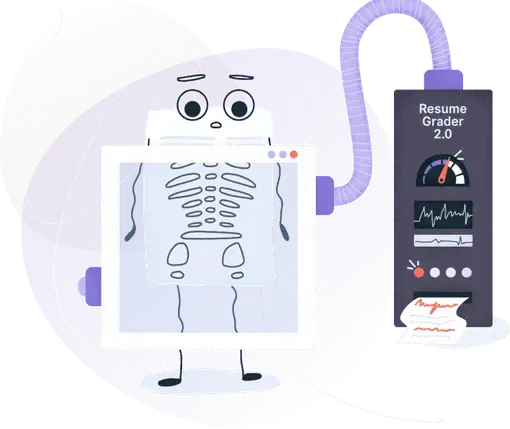Risk Management Skills: Example Usage on Resumes, Skill Set & Top Keywords in 2025
Including risk management on your resume signals to recruiters your ability to identify and mitigate potential threats, highlighting your strategic foresight and proactive attitude. Explore the guide below for inventive ways to express this skill on your resume and discover other phrases that capture your expertise.


Is your resume ATS-friendly?
Drop your resume here or upload a file to find out if the skills in your resume are readable by an ATS.
Risk management skill refers to the ability to identify potential problems before they happen and to develop plans to address them. This skill is useful for making sure projects and operations go smoothly by preventing surprises or minimizing their impact. When you have risk management skills, you can help save a company time and money by avoiding unnecessary setbacks. Companies seek professionals who can foresee difficulties and have strategies ready to keep projects moving forward effectively.
Putting the risk management skill on your resume can show potential employers that you're someone who thinks ahead and plans for the future. However, there are some drawbacks to consider. For instance, if you don't have much experience or concrete examples to back up this skill, it might not carry much weight. In some cases, employers might assume you're overconfident in your ability to control unpredictable factors. To make your resume stronger, focus instead on specific times when you successfully managed risks. It's better to show how you've applied your risk management skills in real scenarios.
In this article, you will learn:
- Drawbacks of including risk management skill on your resume without examples.
- Ways to showcase the application of risk management in real work situations.
- Good and bad examples of how to list risk management skills on a resume.
- Synonyms and alternative phrases for risk management skill used in different job fields.
- Additional skills that complement risk management and strengthen your resume.
- How to demonstrate your thinking and planning skills effectively through your resume.
Misusage of risk management on resumes
Misrepresenting your risk management skills on your resume can lead to serious credibility issues if you're unable to deliver on the expectations you've set with an employer. Exaggerating your proficiency or using jargon that doesn't accurately describe your real experience will not only diminish your reputation but also potentially harm the organization that hires you, trusting in your overstated abilities.
- Summary Section: Claiming to have "expert risk management abilities" when you have only basic understanding can set unrealistic expectations.
- Experience Section: Listing "Risk Management" as a responsibility at a job where you had limited exposure to risk assessment tasks misrepresents your actual level of involvement.
- Achievements Section: Citing "Led a risk mitigation strategy that eliminated all financial risk" when your role in the project was minimal or non-essential inflates your contributions and misleads potential employers.
How to demonstrate risk management skills on your resume
- Highlight your experience identifying and analyzing potential risks, showing how you have helped to minimize threats in previous roles.
- Showcase any successful strategies you implemented for risk mitigation by describing specific projects or situations and the outcomes achieved.
- Illustrate your ability to develop and maintain contingency plans by giving examples of how your planning has benefited a project or organization.
- Demonstrate your proficiency in various risk management frameworks or tools by listing certifications or practical applications from your work experience.
- Emphasize your communication skills by detailing occasions where you effectively conveyed complex risk assessments to stakeholders, leading to informed decision-making.
Example 1: Demonstrate risk management in the experience section
- •Implemented risk analysis process for new insurance products, resulting in a 10% decrease in claim surprises.
- •Coordinated with IT to develop a fraud detection system, reducing fraudulent claims by 15% within the first year.
- •Led quarterly risk assessment reviews, identifying key improvements that raised process efficiency by 20%.
- •Developed comprehensive risk profiles for clients, resulting in more informed strategic decisions.
- •Facilitated the adoption of risk management software, improving client risk visibility by 25%.
- •Conducted industry-specific risk management workshops for over 200 professionals.
- •Overhauled the company’s safety protocol, which reduced workplace accidents by 30%.
- •Conducted hazard assessments and trainings for over 1000 employees, bolstering safety awareness.
- •Managed compliance with OSHA standards, effectively avoiding any significant fines over a 3-year period.
- Each bullet point presents clear, measurable outcomes.
- Different facets of risk management are showcased across varied environments.
- Recent job experiences are detailed, keeping the resume current and relevant.
- No buzzwords are used, which keeps the focus on concrete successes.
- By avoiding repeated content, each job's unique contributions stand out.
Example 2: Demonstrate risk management in the summary section
- The applicant clearly states their experience, focusing on a decade spent in financial analysis and risk management, which immediately informs of their expertise.
- Demonstration of relevant technical skills such as predictive modeling and risk assessment shows they are equipped to handle industry-specific tasks.
- Including a career highlight provides concrete evidence of their achievements, and mentioning a significant reduction in risk positions them as someone who delivers results.
- The direct approach in the summary eschews filler language and gets straight to the point, detailing the applicant’s capabilities and accomplishments.
- This summary speaks directly to prospective employers, assuring them of the applicant’s ability to contribute positively to their financial strategy and objectives.
- Simple language is employed to keep the message clear and comprehensible, ensuring that it's accessible to readers of all levels.
Example 3: Demonstrate risk management in the achievements section
- This example uses clear metrics to demonstrate the impact of the individual's work.
- Title and description length guidelines are well adhered to, making each achievement impactful yet concise.
- Real work situations are provided, showcasing the applicant’s ability to handle challenges and improve processes.
- The descriptions avoid generic buzzwords, providing useful, measurement-based indicators of competency in risk management.
- By including quantifiable results, the achievements make a solid case for the applicant's effectiveness and success in past roles.
What are the relevant certifications for risk management skills on resume
Enhance your profile and skills in risk management with the following professional certifications:
The top 5 certifications for gaining risk management skills expertise:
This certificate equips you with knowledge to analyze and control financial risk, helping you anticipate and respond to financial threats affecting your organization.
The PRM certification focuses on developing a comprehensive understanding of risk management practices, theories, and tools, ideal for professionals aiming for leadership roles in risk management.
This certificate ensures you have a heightened skill set in managing risks, specifically within the insurance industry, by providing strategies and practical solutions for risk assessment and mitigation.
With CRISC certification, you'll have recognized skills in identifying and managing IT risks, and implementing information systems controls, crucial for IT and cybersecurity professionals
This certification showcases your capability to manage enterprise IT risk, and equips you with the skills to design and implement information system controls, supporting businesses in achieving their objectives while mitigating risks.
Top skills people add together with risk management skill on resume:
Financial Analysis
Compliance
Regulatory Knowledge
Project Management
Data Analysis
Business Continuity Planning
Insurance Knowledge
Strategic Planning
Cybersecurity Principles
Audit Techniques
Critical Thinking
Problem Solving
Decision Making
Attention to Detail
Communication
Leadership
Adaptability
Organization
Teamwork
Stress Management
Analytical Thinking
Most relevant jobs for risk management skills
Risk management skills are crucial in positions where evaluating, managing, and mitigating risks are key responsibilities. Professionals in these roles often analyze potential threats and devise strategies to prevent losses for businesses or organizations. A deep understanding of financial markets, legal regulations, and strategic planning is common among jobs in this field. Here's a list of jobs where risk management skills are highly valued:
- Risk Manager
- Financial Analyst
- Compliance Officer
- Insurance Underwriter
- Operational Risk Analyst
- Cybersecurity Analyst
- Project Manager
- Internal Auditor
- Environmental Health and Safety Manager
- Credit Analyst
Key takeaways
- Risk management is a valuable skill on your resume, showing that you can identify and mitigate potential issues in various settings.
- Common misapplications of risk management include using it to avoid all risks rather than managing them, which can be counterproductive; it's essential to know how to balance risk and opportunity.
- To effectively present this skill on your resume, include specific examples of how you've successfully managed risk in past roles, demonstrating your ability to anticipate and solve problems.
Make one that's truly you.




